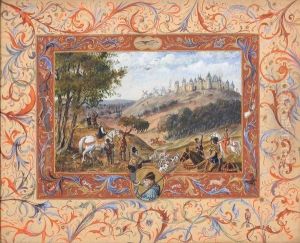Antoine Guiraud Paintings
Antoine Guiraud was a French painter born on July 5, 1802, in Marseille, France. His artistic journey began under the tutelage of Augustin Aubert and later, under the prominent Neoclassical artist Jean-Auguste-Dominique Ingres. Guiraud's style was heavily influenced by Neoclassicism, characterized by clarity of form, sober colors, and historical or mythological subject matter.
In 1825, Guiraud won the coveted Prix de Rome for his painting 'The Death of Tiberius'. This prestigious award granted him a scholarship to the French Academy in Rome, Villa Medici, where he further honed his skills and absorbed the rich artistic heritage of Italy. During his stay in Rome, he was exposed to the works of Renaissance masters, which had a lasting impact on his approach to painting.
Upon his return to France, Guiraud continued to develop his career, exhibiting at the Paris Salon, the official art exhibition of the Académie des Beaux-Arts in Paris. His works from this period often depicted scenes from antiquity and the Bible, reflecting his classical training and interests. Despite his technical skill and classical approach, Guiraud's work did not gain the same level of recognition as some of his contemporaries during the height of the Romantic and emerging Realist movements.
Throughout his life, he also engaged in teaching, passing on his knowledge and skills to a new generation of artists. The latter part of his career was marked by a gradual decline in his output and visibility in the art world, as the public's taste shifted towards more modern artistic movements.
Antoine Guiraud died on November 19, 1882, in Marseille. His body of work remains as a testament to the Neoclassical tradition in French painting, capturing the elegance and disciplined beauty that characterized the era. Although not as widely known today, his paintings are still appreciated for their craftsmanship and adherence to the classical ideals of fine art.
